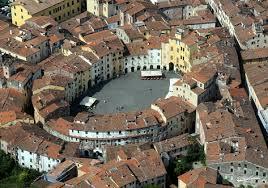Pisa
Pisa is known worldwide for its leaning tower and the other spectacular buildings on the Campo dei Miracoli. The ‘Square of Miracles’ which is slightly away from the city centre is home to the city’s most beautiful attractions: The Baptistery, the imposing Camposanto (a monumental cemetery), the Cathedral of Pisa, and of course the famous leaning tower. But there is more to see in Pisa – it has more than 20 other historic churches, several medieval palaces, and various bridges across the Arno. During the middle ages Pisa was a successful port and much of the city’s architecture was financed from its history as one of the Italian maritime republics.
Pisa is often a landing point for people coming to Tuscany for city breaks owing to its airport which is a major hub for budget airlines, although people often just pass through the town. One option to see more of the town rather than just the tower is the hop-on-hop-off tourist buses which are always a good way to start exploring a city.
You should see the Knights’ Square (Piazza dei Cavalieri), with the Palazzo Della Carovana, with its impressive façade designed by Giorgio Vasari. You may be surprised to find the city is mostly devoid of the renaissance glamour of other cities in Tuscany, but the church on the square Santo Stefano dei Cavalieri, also designed by Vasari, houses a bust by Donatello, and paintings by Vasari, Jacopo Ligozzi, Alessandro Fei, and Pontormo. It also contains spoils from the many naval battles between the Cavalieri (Knights of St. Stephan) and the Turks between the 16th and 18th centuries.
One of the hidden jewels of Pisa is away can be found in the Sant’Antonio square, on one of the walls of the church there is a Keith Haring’s mural called ‘Tuttomondo’. Even some of the locals don’t know of its existence!
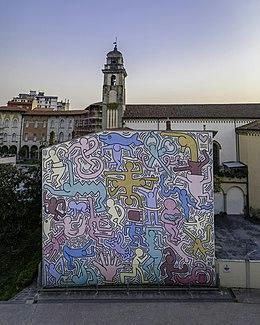
Santa Maria della Spina
Santa Maria della Spina. A small white marble church alongside the Arno, is attributed to Lupo di Francesco (1230), is a beautiful Gothic building like so many in the town.
The Natural history Museum of the University of Pisa is a slightly strange but very interesting museum, It is 10 km outside of the city but is worth it for its collection of whale skeletons which I the largest in Europe. Finally, another slightly unexpected find is the Museum of Ancient Ships which traces over a thousand years of Maritime history in 800 finds: trading and sailors, routes and shipwrecks, navigations and life on board, and the story of the city of Pisa.
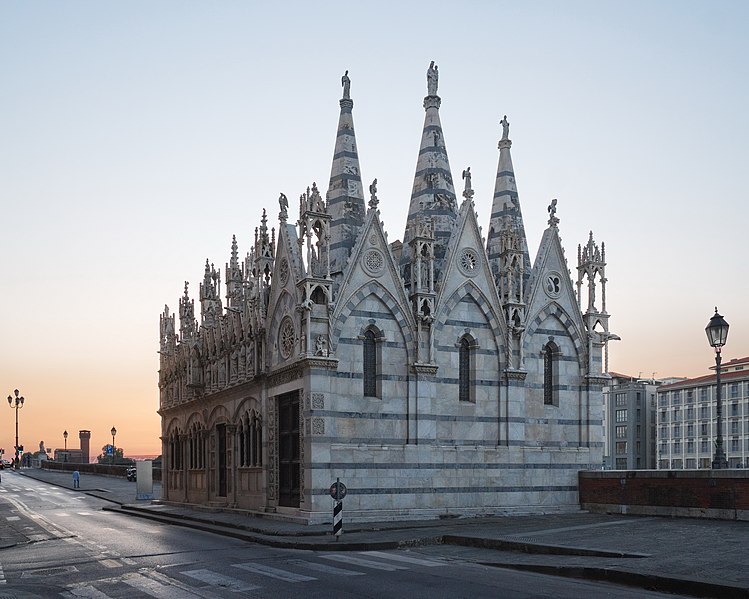
Siena
Siena is a wonderful medieval hill town famous for its art, food and an annual horse race which is much anticipated by locals and tourists alike. The Historic town centre of Siena is a UNESCO world heritage site and is one of the most visited towns in Tuscany. As with most Italian towns the Duomo or Cathedral is top of the list of attractions in Siena. A Romanesque gothic cathedral which boasts valuable artworks by Donatello, the young Michelangelo and works by Bernini which make it an extraordinary museum of Italian sculpture.
At the centre of the historic town is the beautiful fan-shaped Piazza del Campo which dips in the middle, the square is flanked by the Gothic town hall Palazzo Pubblico which has beautiful frescoes inside and Torre del Mangia, a medieval tower over 100 metres high with stunning views from the top.
The square is famous for the Palio di Siena horse race which takes place twice a year and is the highlight of the Sienese Festival calendar on July 2nd and August 16th. It is a bareback horse race dating back to medieval times; ten riders and horses race for 3 laps around the central square, each rider sports the colours and heraldry of one of the 17 districts of the city. Although the race lasts no more than 90 seconds, thousands of people flock to the city to see the race every year.
Aside from the Palio, Siena has a rich cultural history and many artistic treasures and museums to visit. If you are looking for looking for medieval artistic treasures you should not miss the Piccolomini library decorated with frescoes by Pinturicchio and the Pinacoteca Nazionale di Siena. When it comes to food, all the Tuscan favourites are available but pappardelle con la lepre is a local favourite, flat-rib boned pasta with a ragu of hare or wild rabbit or scottiglia chunks of mixed meat; chicken beef rabbit stewed in wine and chilli. For dessert try Passito del Santo a dessert wine made near Siena.
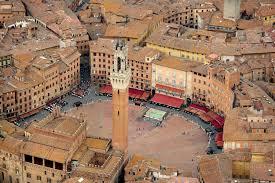
Cortona
This picturesque town made famous by the movie under the Tuscan sun lies 70 miles southeast of Florence. Cortona sits on a steep hillside with breath-taking views of the Valdichiana or the Chiana valley where Tuscany’s famous beef herd graze and Lake Tresimeno, where Hannibal and the Romans met in battle. Luca Signorelli, one of the master painters of the early renaissance came from Cortona, his work can be seen in the Uffizi, Orvieto cathedral and the Sistine chapel in Rome. Cortona is quainter and has a quieter pace of life than Pisa or Siena but is an unexpected jewel for Etruscan history. The town is still surrounded by walls and walking around the historic centre will take you back to simper times. The MAEC Museum has a number of important Etruscan finds predominantly from the surrounding area including two tombs about 4 km from the town. Here you find not only Etruscan and Roman artefacts including a huge chandelier from the 5th century but also painting by noteworthy artists such as Pietro da Cortona, Luca Signorelli and Pinturicchio who would work in Florence and Rome. At the Diocesan museum, situated in an old church you can see two paintings by Fra Angelico who spent ten years in Cortona’s Dominican monastery. Villa Bramasole where ‘under the Tuscan sun was written’ is an attraction for tourists, the Villa was indeed bought and restored by an American Novelist and can be visited today. One of the main charms of Cortona is the quintessential slice of Italian village life and the amazing produce available in local restaurants.
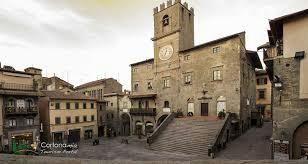
San Gimignano
Known as the town of fine towers, San Gimignano is a walled hill-town in the centre of Tuscany, it is famous for the medieval towers that mark the skyline which have captured the imagination of writers and artists alike. The English film Tea with Mussolini is set in San Gimignano and tells of a group of British women trapped in the town by Mussolini’s troops.
The historic centre is a UNESCO world heritage site with Romanesque and Gothic architecture, outstanding examples of secular buildings as well as churches.
The 14 towers dotted around the town which can be seen from a distance are the remnants of the noble families who vied for power in the region. Today they still bear the names of the families who built them like, Torre Campatelli, Torre Chigi and so on. They were symbols of power (the taller the tower the more powerful the family) but they also served as a territorial markers for the area controlled by elite families who vied for dominance from medieval times onwards. Few remain as they have disappeared through the ages thanks to war, disaster or urban renewal, some have been enveloped by large palaces or walls.
San Gimignano is small and can be seen in half a day; we suggest you take a stroll around the old town, visit Piazza Della Cisterna and visit Torre Grossa the tallest tower (54m) and the only one
Known as the town of fine towers, San Gimignano is a walled hill-town in the centre of Tuscany, it is famous for the medieval towers that mark the skyline which have captured the imagination of writers and artists alike. The English film Tea with Mussolini is set in San Gimignano and tells of a group of British women trapped in the town by Mussolini’s troops.
The historic centre is a UNESCO world heritage site with Romanesque and Gothic architecture, outstanding examples of secular buildings as well as churches.
The 14 towers dotted around the town which can be seen from a distance are the remnants of the noble families who vied for power in the region. Today they still bear the names of the families who built them like, Torre Campatelli, Torre Chigi and so on. They were symbols of power (the taller the tower the more powerful the family) but they also served as a territorial markers for the area controlled by elite families who vied for dominance from medieval times onwards. Few remain as they have disappeared through the ages thanks to war, disaster or urban renewal, some have been enveloped by large palaces or walls.
San Gimignano is small and can be seen in half a day; we suggest you take a stroll around the old town, visit Piazza Della Cisterna and visit Torre Grossa the tallest tower (54m) and the only one open to the public it is one of the attractions of the town today – you can climb to the top and take in the views.
San Gimignano is a foody heaven and so a great spot for lunch. It was the Italian capital for Saffron, grown exclusively in the area since the 1200s and local dishes reflect this. Also known for its artisanal cheeses – different types of pecorino Toscano a sheep’s cheese, cured meats and its white wine. Vernaccia di San Gimignano is a crisp, dry white wine produced from the ancient variety of Vernaccia grape which is grown on the sandstone hillsides of the area, considered one of Italy’s finest white wines today and noted for its excellence by Dante Alighieri in his ‘Inferno’.
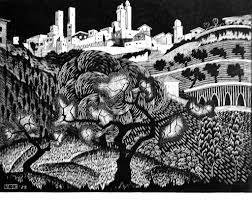
Lucca
Lucca is another small town that cannot be missed. It lies in the North east of Tuscany conveniently located close to Pisa; you can spend a full day soaking in the wonderful atmosphere. Known for its city walls which are mostly in tact and its numerous churches it is a wonderful place to explore full of medieval architecture, palaces, piazzas and museums.
Lucca is an ancient town, founded by the Etruscans and then taken by the Romans, it was where the Triumvirs Crassus and Caesar met to form their alliance. The historical centre preserves the rectangular Roman street plan, Piazza San Michele occupies the site of the ancient forum. If you have visited the Colosseum in Rome, you may see some similarities as you enter the Piazza dell’Anfiteatro, which is completely closed except for two opposing entrances – the buildings surrounding the piazza were built into the remains of an amphitheatre. The central piazza surrounded by shops and restaurants is a wonderful place to stop for coffee or lunch.
The historic centre is still surrounded by 4km of walls (the best preserved in Italy) which are part of its charm; you can walk around the entire town on the huge fortifications or even hire a bike and cycle around it! In the south eastern corner of the old town you will find the beautiful Botanical Gardens of Lucca which cover two of the bastions on the city walls. Not only a colourful and shady spot, there are several greenhouses, an arboretum, a herbarium and several ponds and water features, not to mention a veritable explosion of flora.
Of the many churches you shouldn’t miss the Duomo or cathedral in Piazza San Martino, it has a beautiful façade with a series of opulent archways and an ornate portico. To the side of the building is the campanile or bell tower which looks rather odd in its unfinished state – only the top half is revetted in marble while the rest is brick. Inside are works by numerous important artists including Michelangelo and Raphael’s mentor Domenico Ghirlandaio, Federico Zuccari, Jacopo Tintoretto and Fra Bartolomeo. The Basilica di San Michele in Foro which dates back to the 8th century and is built on the old Roman forum has an impressive façade as does the Basilica of San Frediano in the heart of Lucca with a coloured mosaic from the 14th century.
The Torre Guinigi is one of Lucca’s historical towers standing over 45m tall, what is extraordinary about this one is the garden and oak trees on top, which have made this tower a symbol of Lucca.
There are many places to eat and drink in Lucca from fine dining at Ristorante Gatta Ci Cova, romantic dining at Buca di Sant’Antonio or rustic local places hidden in small piazzas like Trattoria Gigi. Try local specialities like Tordelli Lucchese pasta stuffed with beef, pork or green vegetables with a unique nutmeg flavour, or Lucchese steamed dumplings made of ricotta and spinach.
